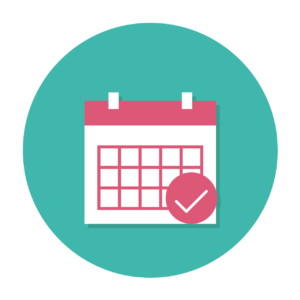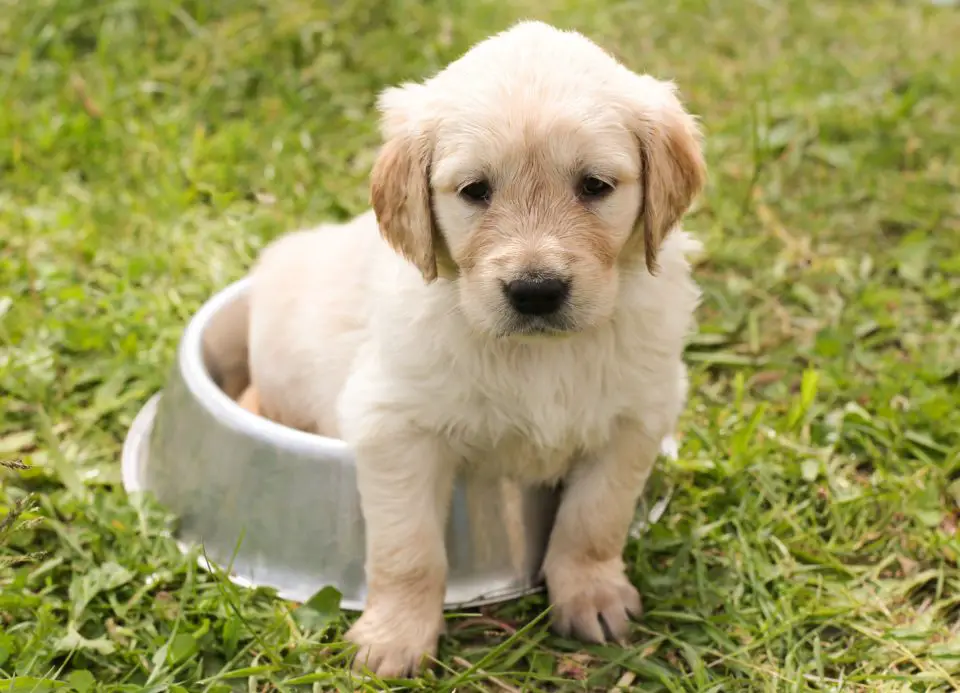Hello, my name is Valerie and I am the owner of a Clumberdoodle called Bentley.
Bentley came to live with us at the tender age of 15 weeks, and while he has been the joy of our lives from that day, there are some things that baffled me when we first brought him home.
 One thing that I simply could not get my head around was just how much this little furry bundle could pee! Now, I am sure that I was not alone in this situation. It seemed like every five minutes I was mopping up another puddle.
One thing that I simply could not get my head around was just how much this little furry bundle could pee! Now, I am sure that I was not alone in this situation. It seemed like every five minutes I was mopping up another puddle.
Because Bentley came to us at 15 weeks, the owner had already potty trained him, so it came as a great shock when he did not automatically head outside to pee. I decided to do a little research about why puppies pee so much.
So, What’s the Normal Amount for a Puppy to Pee?
Here’s an interesting calculation I found. Your 1.5kg pup should produce 3ml of urine in an hour. That’s about 72ml per day. It seems that it is not uncommon for a pup to pee up to 24 times a day!
No wonder I felt like the pee taxi, ferrying the pup outside every ten minutes! Of course, if he drinks more than average you can expect this to increase. We found that Bentley really enjoyed drinking water and we were constantly refilling the water bowl for him. Hence, more pee.
I don’t think it’s ever a good idea to restrict water intake. If you do, I would expect health issues to develop, so I keep his water bowl topped up with fresh water all the time.
The figures above were from the ‘average’ pup, and who has one of those? There is no such thing as an ‘average’ pup, they are all individual, and differ from each other, so there is no reason why this should not apply here.
But it is a guideline, so if you notice that your pup is peeing much less, or even much more, you may want to have a chat with your vet and make sure all is okay.
They also apply to a pup of 8-10 weeks old who possibly does not have the best bladder control. As Bentley was a little older, I looked at other reasons why he peed so much, and most of the time, in the house.
I think the reason that our boy peed so much was nothing more than anxiety on arriving in his new home, and not knowing where he was supposed to pee. His little world had changed dramatically, and he just did not know where his toilet area was.
Once we sorted out his special area, things improved overnight.
Some Reasons for Your Pup to Pee so Much
 If you bring your pup home at 8 weeks (or at 15 as I did) you need to ask whether he has ever really been toilet trained.
If you bring your pup home at 8 weeks (or at 15 as I did) you need to ask whether he has ever really been toilet trained.
Don’t assume that the person you got him from will have done it all.. it’s worth asking a few questions before you collect your pup.
A visit to the vet will rule out any medical condition for your pup to pee all the time.
This will also set your own mind at rest.
Puppies may pee a lot because they are stressed out. They may be anxious when you leave him at home, I know Bentley still gets anxious when I go out, and this is quite common.
The pup is in the house with you and family, and then he is left on his own. It’s a huge area for him to guard while you are out and will most likely leave him anxious.
You will know he is anxious if you come home to puddles. As he gets older and pees against things, this is a sign of marking his territory.
While many people will tell you that you should never leave a pup along, sometimes it is not possible to take them with us wherever we go. I found that leaving the pup in a smaller place made him feel less stressed. There was less area for him to guard. I remember my mum always shutting the dog in the kitchen when we went out.
There is some wisdom in this, because we never came home to a house that was trashed. If the dog had peed, it was contained in one area.
Leaving Bentley in the kitchen was not a smart move though, as he was always a strong pup and can reach up and into things. I did come home to several chewed wooden spoons. When I realised that he would not be safe in the kitchen, I opted for a crate when we went out.
You may, or may not agree with crating, but it did stop him peeing when I went out.
If you’re considering getting a crate, which can be a great ideal, especially for younger dogs, check out our guide here!
Try to Keep a Schedule
 There is a really good way to see if your pup is peeing too much, or too little. Keep a schedule or pee chart. Any notebook will be fine for this.
There is a really good way to see if your pup is peeing too much, or too little. Keep a schedule or pee chart. Any notebook will be fine for this.
Make a note of the time he pees, whether it is after a meal, after a play session, when a visitor arrives. In fact, the more info you can keep on this, the better you will be able to see if he is peeing normally.
It’s also a great idea because you will start to see a pattern developing, and you will know to encourage him to pee before you go out.
Medical Problems can be to Blame…
If this merits a visit to the vet, you can expect them to do a urinalysis first. This will tell the vet if there is a bladder infection. Bladder infections will most likely make your pup pee a lot more. If you’ve ever had a UTI yourself you will know that while it may hurt like crazy, drinking lots of water and peeing often is good to get rid of bacteria. Your pup will instinctively want to do this.
Pollakiuria is a condition where the bladder is irritated. You may notice that your pup pees in small amounts instead of a decent amount every time. This is because the bladder gets a little enlarged like a balloon, and the urethra – being a small tube – battles to cope with the flow.
One condition that has a different show, is if your pup seems to be peeing while he is asleep. The condition is called sphincter laxity and you should take him to the vet right away. He may be fast asleep and wake up to a wet bed. This is because he has no control over the incontinence.
What I have learned is that any bladder problems mean that your pup is in some pain and discomfort, and all of them need to be treated as soon as possible.
When should you seek professional help?
 Well, if there is ever blood in the urine, a visit to the vet is needed ASAP. If your pup seems to be in pain or distress when he pees, he needs to be checked out.
Well, if there is ever blood in the urine, a visit to the vet is needed ASAP. If your pup seems to be in pain or distress when he pees, he needs to be checked out.
While it may be ‘normal’ for a pup to pee a lot each day, if things suddenly change and you notice a difference, see the vet.
As your pup grows, and of course the longer he and you are together, the better you will know his pee routine. If it changes significantly, make that appointment, because he is in some amount of discomfort.
If you ever think anything ism’t quite right with your pup, get the to the vet!
What about older dogs and dogs on medication?
If a dog is suspected of having kidney failure, it will be hooked up to a device which measures urine output. This will be done by the vet in the doggie hospital under supervision. In the case of kidney failure your dog will pee less urine than he normally would.
This situation is life-threatening and if you notice that his output decreases significantly, you must get him to the vet.
On the other hand, diseases such as Diabetes and Cushing’s Disease will make your dog produce huge amounts of urine.
Both these situations are more common in older dogs, and both can be fatal if not treated.
So, now that we’ve looked at reasons for all that pee from your pup, what can we do about it? There are several strategies which will help when dealing with this.
- Watch the water
Now, it is not a good idea to stop or regulate his water intake, but he also does not need to have a full bowl of water all the time. On average most dogs need ¼ cup of water for each of their weight in pounds, per day. This will keep him hydrated and provide all the flushing his body needs. Any more water will increase his urinating.
- Stop before bed time
It’s a good idea to remove water a few hours before bed time. Also, it is important that you let your furry friend out to pee before bed. Bentley is very good at using delay tactics because he would prefer to stay out in the garden, but eventually he will pee and then we can both go back inside. It only took a few days for the habit to become ingrained at night.
- Make a sleep cycle
This, as I found with Bentley, works very well. I know he will sleep for at least seven hours before wanting to go out and pee in the morning. So right after he has peed at night, it is bed time for both of us.
What is good with Bentley is that at 8am on almost every morning, I will be woken by him tapping my arm to go out and pee. If your dog does this, great. But in the early days, you may want to set an alarm to wake both of you. Once you have created a routing where he knows he can ask to go out, your problem is almost over.
 Accidents do occasionally happen, and I have learned that Bentley does not make them on purpose. He very seldom wakes me in the wee hours, but if he does, we go out and back, and off to sleep.
Accidents do occasionally happen, and I have learned that Bentley does not make them on purpose. He very seldom wakes me in the wee hours, but if he does, we go out and back, and off to sleep.
Remember your pup is still learning. Young pups need to learn to control their bladders, just like a toddler who is being potty trained. I found that I helped to establish a pee pattern by setting myself a time to take Bentley out.
Can I Help to Stop my Puppy Peeing so Much?
Yes, of course we can help our furry friends through this stage. Let’s assume that our pup is under three months of age.
At this point in his life he has not completely mastered the ability to control his bladder. He is similar to a very young child.
Every parent who is going through the potty training stage with a little one will know that when they indicate that they need to go to the toilet, you have to find one right away.
Parents learn at this stage where to spot a toilet from every point they find themselves.
Parents become very good at working the events of the day around the toddler’s bowel movements.
Helping your pup is just the same as this. You need to anticipate your pups need to pee and get him firstly out of the house in time, and secondly, to the area that you want him to use.
If you work throughout the day, which let’s face it, most of us do! You may think it’s difficult to potty train your pup at first…
But don’t worry, we’ve put together a guide on how to potty train your puppy whilst at work, which you can check out here! 🙂
Anyway, With Bentley I found that – as soon as I got my head around his many pee visits – I was able to see from his movements that he needed to go outside. If you watch your pup, you will notice subtle changes which will tell you he needs to pee. The secret here is to drop what you are doing and focus on him.
Remember that your average pup will want to pee up to 24 times a day, so it makes sense to devote the first day or so entirely to him. On the second day with Bentley, I cleared my schedule of doing everything other than watching him, and while this may seem radical, it worked for us.
All that pee – and there was a huge amount – was done outside instead of on the floor.
Once Bentley had figured out where he was supposed to pee, he started to take himself out without my help. Obviously, there were accidents every so often. You really can’t expect a pup to get it right every single time, and Bentley was no different here.
One thing I have learned is that sometimes it is a good idea to make use of puppy training mats. Now these are inexpensive and will work wonders if you need to use them with your pup. If your house is very large and your pup can’t get to the door and outside in time, it’s a good idea to use a pee pad as a stop gap halfway between the two spots.
I tend to use the “California Pet Supply Dog Training Pads” as they can be bought online you get 50 for a really good price!
Once your pup has learned that it is acceptable to pee on the pad, you simply start to move it closer to the door. Once the pad is at the door, move it to right outside the door. Each time you will be training your pup to hold it just a little further, and his bladder control will improve.
What still amazes me about Bentley is that he is a fast learner – and I think most dogs learn in their own time – but peeing in his own special area soon becomes a habit.
Now I want to show you Bentley’s own perfect pee accessory…
Design Toscano Fire Hydrant Statue Puppy Pee Post
Yes, I know you will all be rushing out to order this!
I did, as soon as I saw it. It only took a short while for Bentley to start to use his own personal pee spot.
Not only does the hydrant look really cute in the garden, but he gets to head out to that spot every time.
It’s good value for money, mostly the amusement factor, and the comments from some of our neighbours, but also does the job of giving your dog his own personal space.
How Did we Get Him to Use His Hydrant?
Well, it was very easy to do this. Once he had peed a few times in his own spot, I simply placed the hydrant with an amount of sand that he had peed on before.
He soon got used to heading straight for it.
Mind you, plenty of praise and a few treats helped. But that’s the way it goes when we have a dog, isn’t it?
Final Thoughts
 So, now that we’re at the end of this article about how much our pup pees, I hope I’ve covered most things you need to know.
So, now that we’re at the end of this article about how much our pup pees, I hope I’ve covered most things you need to know.
Basically, a pup pees a lot – a whole lot – and simply needs to be shown where to deposit it. This doesn’t mean on your living room floor.
Bladder control will come in time, and unless your pup has a medical problem, he will soon master the art of peeing where you want him to.
I learned that patience is the key, (isn’t this the same as with a toddler?) and just knowing that he’s doing his best to pee where you want is important.
Accidents will happen, unfortunately. I tried to just ignore them, mop up and get on with life, and this seemed to work well.
I also believe that getting to know your pup will help you spot anything that is out of the ordinary. A drastic change in his pee output, either too much or too little is cause for concern and a vet visit is needed.
So, after all the ‘potty training, Bentley is a ‘more or less’ well adjusted pooch who knows he is loved very much. I know he’ll tell me in the morning when he wants to go out, and I also know I can expect about eight hours of sleep now.
What’s even better is that all that pee is going in the right place – outside!



